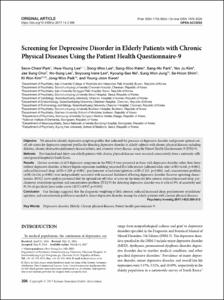Screening for Depressive Disorder in Elderly Patients with Chronic Physical Diseases Using the Patient Health Questionnaire-9
- Keimyung Author(s)
- Jung, Sung Won
- Department
- Dept. of Psychiatry (정신건강의학)
- Journal Title
- Psychiatry Investigation
- Issued Date
- 2017
- Volume
- 14
- Issue
- 3
- Abstract
- Objective;
We aimed to identify depressive symptom profiles that indicated the presence of depressive disorder and present optimal cut-off sub-scores for depressive symptom profiles for detecting depressive disorder in elderly subjects with chronic physical diseases including diabetes, chronic obstructive pulmonary disease/asthma, and coronary artery disease, using the Patient Health Questionnaire-9 (PHQ-9).
Methods;
Two hundred and thirty-one elderly patients with chronic physical diseases were recruited consecutively from a university-affiliated general hospital in South Korea.
Results;
Greater severities of all 9 depressive symptoms in the PHQ-9 were presented in those with depressive disorder rather than those without depressive disorder. A binary logistic regression modeling presented that little interest [adjusted odds ratio (aOR)=4.648, p<0.001], reduced/increased sleep (aOR=3.269, p<0.001), psychomotor retardation/agitation (aOR=2.243, p=0.004), and concentration problem (aOR=16.116, p<0.001) were independently associated with increased likelihood of having depressive disorder. Receiver operating characteristics (ROC) curve analysis presented that the optimal cut-off value of score on the items for little interest, reduced/increased sleep, psychomotor retardation/agitation and concentration problem (PHQ-9) for detecting depressive disorder was 4 with 61.9% of sensitivity and 91.5% of specificity [area under curve (AUC)=0.937, p<0.001].
Conclusion;
Our findings suggested that the diagnostic weighting of little interest, reduced/increased sleep, psychomotor retardation/agitation, and concentration problem is needed to detect depressive disorder among the elderly patients with chronic physical diseases.
- Keimyung Author(s)(Kor)
- 정성원
- Publisher
- School of Medicine
- Citation
- Seon-Cheol Park et al. (2017). Screening for Depressive Disorder in Elderly Patients with Chronic Physical Diseases Using the Patient Health Questionnaire-9. Psychiatry Investigation, 14(3), 306–313. doi: 10.4306/pi.2017.14.3.306
- Type
- Article
- ISSN
- 1738-3684
- Appears in Collections:
- 1. School of Medicine (의과대학) > Dept. of Psychiatry (정신건강의학)
- 파일 목록
-
-
Download
 oak-2017-0369.pdf
기타 데이터 / 546.87 kB / Adobe PDF
oak-2017-0369.pdf
기타 데이터 / 546.87 kB / Adobe PDF
-
Items in Repository are protected by copyright, with all rights reserved, unless otherwise indicated.